
The Type 23 frigate or Duke class is a class of frigates built for the United Kingdom's Royal Navy. The ships are named after British Dukes, thus leading to the class being commonly known as the Duke class. The first Type 23, HMS Norfolk, was commissioned in 1989, and the sixteenth, HMS St Albans was commissioned in June 2002. They form the core of the Royal Navy's destroyer and frigate fleet and serve alongside the Type 45 destroyers. They were designed for anti-submarine warfare, but have been used for a range of uses. Ten Type 23 frigates remain in service with the Royal Navy, with three vessels having been sold to the Chilean Navy, one being retired in 2021, and two being retired in 2023.

The Type 22 frigate also known as the Broadsword class was a class of frigates built for the British Royal Navy. Fourteen were built in total, with production divided into three batches.

Almirante Condell is a Duke-class Type 23 frigate in service with the Chilean Navy. It entered service with the Royal Navy in 1991 with the name HMS Marlborough as the sixth ship to bear the name. She was named after John Churchill, 1st Duke of Marlborough, and served in the Middle East. The frigate was taken out of service in 2005 and sold to Chile. The vessel entered service with the Chilean Navy in 2008 and was renamed Almirante Condell after Carlos Condell, a Chilean naval officer during the War of the Pacific. The ship was significantly upgraded from 2020 to 2021 and remains in service.

HMS Grafton is a Type 23 frigate formerly in service with the Royal Navy. She was the ninth vessel to bear the name, and is named after the Duke of Grafton. Ordered in January 1992, Grafton was laid down on 13 May 1993 by Yarrow Shipbuilders. The frigate was launched on 5 November 1994 and commissioned into the Royal Navy on 29 May 1997 with the pennant number F80. In 2007 the ship was transferred to Chile as Almirante Lynch and, having undergone a significant upgrade from 2019 to 2020, remains in service with the Chilean Navy.
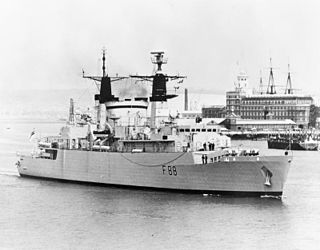
HMS Broadsword was the lead ship and first Batch 1 unit of the Type 22 frigates of the Royal Navy.

The Type 21 frigate, or Amazon-class frigate, was a British Royal Navy general-purpose escort that was designed in the late 1960s, built in the 1970s and served throughout the 1980s into the 1990s.

HMS Coventry was a Type 42 (Sheffield-class) destroyer of the Royal Navy. Laid down by Cammell Laird and Company, Limited, at Birkenhead on 29 January 1973, she was launched on 21 June 1974 and accepted into service on 20 October 1978 at a cost of £37,900,000.

The MICA, abbreviated from its full name Missile d'Interception, de Combat et d'Auto-défense or alternate translation is a French anti-air multi-target, all weather, fire-and-forget short and medium-range missile system manufactured by MBDA France. It is intended for use both by air platforms as individual missiles as well as ground units and ships, which can be equipped with the rapid fire MICA Vertical Launch System. It is fitted with a thrust vector control (TVC) system. It was developed from 1982 onward by Matra. The first trials occurred in 1991, and the missile was commissioned in 1996 to equip the Rafale and Mirage 2000. It is a replacement for both the Super 530 in the interception role and the Magic II in the dogfighting role.
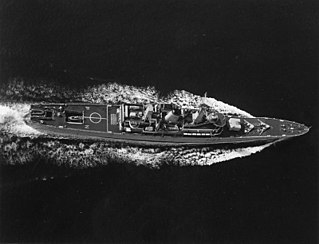
HMS Penelope was a Leander-class frigate of the Royal Navy. In the Falklands War, Penelope fired on an Argentine patrol boat and claimed to be the last ship attacked by Argentine aircraft over the course of the war. In 1991, she was commissioned into the Ecuadorean Navy, and renamed Presidente Eloy Alfaro.

The Type 82 or Bristol-class destroyer was a 1960s guided missile destroyer design intended to replace County-class destroyers in the Royal Navy. Originally eight warships were planned to provide area air-defence for the four planned CVA-01 aircraft carriers. They would also have been able to operate independently as modern cruisers "East of Suez".

The Principal Anti-Air Missile System (PAAMS) is a joint programme developed by France, Italy, and the United Kingdom for an integrated anti-aircraft warfare system. The prime contractor is EUROPAAMS, a joint venture between Eurosam (66%) and UKAMS (33%). In the United Kingdom, PAAMS has been given the designation Sea Viper.
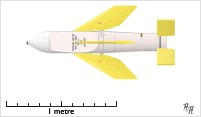
Seacat was a British short-range surface-to-air missile system intended to replace the ubiquitous Bofors 40 mm gun aboard warships of all sizes. It was the world's first operational shipboard point-defence missile system, and was designed so that the Bofors guns could be replaced with minimum modification to the recipient vessel and (originally) using existing fire-control systems. A mobile land-based version of the system was known as Tigercat.

A vertical launching system (VLS) is an advanced system for holding and firing missiles on mobile naval platforms, such as surface ships and submarines. Each vertical launch system consists of a number of cells, which can hold one or more missiles ready for firing. Typically, each cell can hold a number of different types of missiles, allowing the ship flexibility to load the best set for any given mission. Further, when new missiles are developed, they are typically fitted to the existing vertical launch systems of that nation, allowing existing ships to use new types of missiles without expensive rework. When the command is given, the missile flies straight up far enough to clear the cell and the ship, then turns onto the desired course.
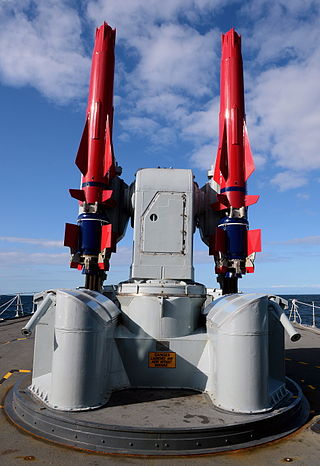
Sea Dart, or GWS.30 was a Royal Navy surface-to-air missile system designed in the 1960s and entering service in 1973. It was fitted to the Type 42 destroyers, Type 82 destroyer and Invincible-class aircraft carriers of the Royal Navy. Originally developed by Hawker Siddeley, the missile was built by British Aerospace after 1977. It was withdrawn from service in 2012.

The RIM-162 Evolved SeaSparrow Missile (ESSM) is a development of the RIM-7 Sea Sparrow missile used to protect ships from attacking missiles and aircraft. ESSM is designed to counter supersonic maneuvering anti-ship missiles. ESSM also has the ability to be "quad-packed" in the Mark 41 Vertical Launch System, allowing up to four ESSMs to be carried in a single cell.

The Rothesay class, or Type 12M frigates were a class of frigates serving with the Royal Navy, South African Navy and the Royal New Zealand Navy.
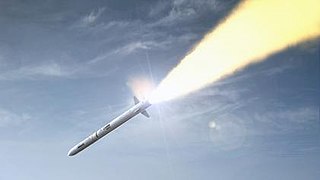
The CAMM is a family of surface-to-air missiles developed by MBDA UK for the United Kingdom. CAMM is derived from, and shares some common features and components with, the Advanced Short Range Air-to-Air Missile (ASRAAM), but with updated electronics, a soft vertical launch system, and an active radar homing seeker. The CAMM family is either currently in-use or has been ordered by ten nations.

The Mark 41 Vertical Launching System is a shipborne missile canister launching system which provides a rapid-fire launch capability against hostile threats. The Vertical Launch System (VLS) concept was derived from work on the Aegis Combat System.
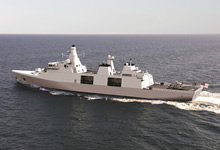
The Type 31 frigate, also known as the Inspiration class, and formerly known as the Type 31e frigate or General Purpose Frigate (GPF), is a class of five frigates being built for the United Kingdom's Royal Navy, with variants also being built for the Indonesian and Polish navies. The Type 31 is intended to enter service in the 2020s alongside the eight submarine-hunting Type 26 frigate and will replace the five general-purpose Type 23 frigates. The Type 31 is part of the British government's "National Shipbuilding Strategy".
The Type 83 destroyer is a proposed class of guided-missile destroyers which is planned to enter service with the United Kingdom's Royal Navy in the mid-to-late 2030s. It is being developed as a direct replacement for the current flotilla of six Type 45 destroyers.




























